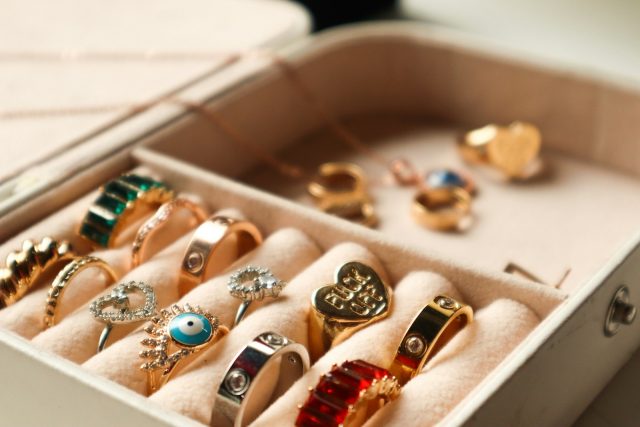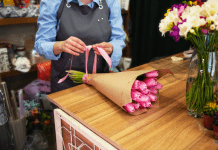
It’s tough when your jewelry collection just doesn’t shine on display. Many of us have dealt with tangled necklaces and crowded shelves before. After testing eight different ways to show off jewelry, some options really stood out.
This guide shares how smart lighting makes every piece look brighter, while simple trays and bust stands keep things neat and easy to see. Even digital displays can add an exciting touch to any store setup.
Follow these clear steps to help your jewels stand out and bring in more happy customers.
Strategic Use of Themes in Jewelry Displays
Themes help set a clear mood for each jewelry display, whether I spotlight fine jewelry or playful statement pieces. I shift between seasonal looks and feature event-specific colors, which keeps customers curious…
and coming back for more.
Grouping by Collection or Style
I group jewelry by style, color, and metal type. Gold engagement rings sit in one tray, while silver dangle earrings hang together on a rack. I keep statement necklaces next to each other to draw attention.
Labels mark categories like wedding bands or minimalist pieces for easy shopping.
Each item has a unique SKU or ID tag; storage bins have clear labels like “Gold 18K Chain” or “Silver Amethyst Ring.” Barcodes and QR codes speed up sales at the point of sale system.
Clear dividers help split collections into neat groups, so customers can compare fine jewelry without confusion. This setup matches my brand identity and makes the store feel organized—less is more always works best for visual merchandising.
Incorporating Seasonal and Event-Specific Displays
Window displays with bold seasonal themes, like Valentine’s Day hearts or winter snowflakes, grab attention fast. I use promotions and bright visuals to boost foot traffic into my jewelry store.
Decorative props such as pumpkins for fall or simple flowers for spring keep displays fresh.
I refresh featured fine jewelry pieces every week or month so my collection always feels new and on trend. Covering baseboards in a single color makes the look cohesive; changing colors once every quarter keeps things interesting.
Special events, such as trunk shows or product launches each season, bring buzz and help showcase luxury jewelry.
With statement pieces front and center during big retail moments—Black Friday sales or Mother’s Day gift ideas—I make sure customers see something exciting right away. Seasonal merchandising draws people closer to the point of sale system where they can buy their favorites quickly.
This approach lifts both customer experience numbers and sales in my retail store.
Maximizing Visual Impact
I use lighting to make every piece shine—spotlights help gemstones and precious metals stand out. Careful spacing keeps display jewelry organized, so each bracelet or ring stands out without feeling crowded.
Using Lighting to Enhance Sparkle
Natural light always makes jewelry collections stand out. I place displays near windows or skylights to boost the sparkle and show off true colors. Bright sunlight creates brilliance in fine jewelry, statement pieces, and precious metals.
If natural light is not available, energy-efficient LED lights with a 2700K color temperature give warmth and clarity. Warm white LEDs prevent colors from looking dull and help each ring, bracelet, or necklace shine.
Spotlights focus attention on diamonds in display cases while layered accent lighting shows details without harsh shadows. Fluorescent bulbs never work well since they wash out gemstones and make luxury jewelry look flat.
Proper lighting for jewelry merchandising gives customers clear views of every piece at any point of sale system or interactive display window—always making brands memorable and enhancing customer experiences.
Balancing White Space with Product Density
I use blank space to stop jewelry displays from looking crowded. I only show one of each item, so the display looks special and not like there’s too much stock. Too many items on a tray or shelf make fine jewelry hard to see and keep luxury pieces from standing out.
I make groups of 3 or 5 single ring displays for balance and more interest. For necklaces, taller bust stands go in back with shorter ones in front, so nothing blocks the view. High-end statement jewelry sits alone on minimalist trays with plenty of space around it; this draws attention right away.
Clean cloths help me remove dust every day, keeping everything fresh at the point of sale area. Good spacing works best with strong lighting for maximum sparkle—next, I’ll share how proper light can enhance precious metals in your collection.
Effective Display Techniques
A good jewelry display keeps pieces neat and easy to see, which helps shoppers pick out their favorites. I use stands or trays in my store—each one suits different types of fine and luxury jewelry for better organization and visual appeal.
Bust Stands and Tiered Displays for Necklaces
I set up bust stands to highlight the length and design of each necklace. I always use tall stands for longer pieces at the back, with shorter ones in front. This creates layers that catch a shopper’s eye right away.
Tiered displays let me show 3 or more necklaces side by side, making it easy to compare chains by metal type or style.
I keep gold jewelry on light-colored surfaces or mirrored backgrounds so every detail pops under proper lighting for jewelry displays. High-priced necklaces—my “hero” items—get solo spots using single neck forms.
Mixing trays with bust stands adds hierarchy and keeps the display clean but full. Using these tools helps me organize fine jewelry collections while supporting suggestive selling at any point of sale counter.
Creative Hanging Displays for Earrings
I use creative hanging jewelry displays to make earrings stand out. Hanging racks or earring stands give each piece space and prevent clutter in the showcase. I elevate drop and statement earrings on mirrored pedestals or hang them near entrances, where over 80% of shoppers pause first.
Color groupings help gemstone earrings catch attention fast; I keep similar colors together for better visual impact. For luxury jewelry, I choose neutral display cases so details pop under store lighting.
Clip-type holders work best for intricate designs, while shelf-style panels support larger sets.
Seasonal props like spring flowers or metallic accents refresh the point of sale area every two months. Displaying fine jewelry in high-traffic spots always boosts exposure by up to 30%.
These simple merchandising tricks fit any jewelry collection, making browsing easy and inviting for customers every day.
T-Bar Stands and Trays for Bracelets and Rings
T-Bar stands display up to 10 bracelets or bangles side by side. I keep these in easy-to-reach spots, so customers see and touch them fast. For rings and smaller jewelry pieces, trays with compartments work best.
These trays stop tangling and make browsing simple for anyone shopping my jewelry collection. Grouping similar items together—like all gold rings or silver bracelets—helps shoppers compare styles at a glance.
I use sets of three or five to show off statement jewelry pieces like stackable rings on each tray; this draws eyes right away. Clear plastic cases help organize precious metals while stopping tarnish and rust over time.
Branded tags with unique SKUs go under each bracelet or ring for quick inventory checks using my point of sale (POS) system. Next up: digital displays can take engagement further in any modern jewelry store design.
Leveraging Technology and Interactivity
I use touch screens, smart mirrors, and tablets to grab attention—this makes shopping for jewelry collections more fun. Virtual try-ons or QR codes can boost interest and help buyers picture themselves with new statement pieces or luxury jewelry.
Digital Displays and Virtual Try-Ons
Digital displays add movement and life to my jewelry collection in-store. I use screens and digital signage to show sparkling fine jewelry pieces from many angles. This keeps customers interested, especially with new arrivals or flash promotions shown in real time.
People see statement pieces shine right on the screen.
Virtual try-ons change how shoppers connect with jewelry displays. Smart mirrors or tablets let customers try luxury jewelry before they buy, using augmented reality tools by companies like Modiface and Perfect Corp.
I place QR codes next to each item, so anyone can scan them for instant info or 360-degree views in a digital catalog that lists SKUs for every style. These interactive features boost engagement and help retailers increase sales quickly while making shopping more fun and personal.
Interactive Elements to Engage Customers
Mirrors at each jewelry display let shoppers see necklaces, bracelets, and earrings on themselves right away. I use interactive displays that offer virtual try-ons for statement pieces and fine jewelry.
My store hosts in-store events like live demos every 2 weeks to build excitement. Shoppers can touch and handle luxury jewelry, feeling the weight of precious metals.
Point-of-purchase stands at checkout show stud earrings and charms; I refresh these spots every month to boost impulse sales by up to 15%. Touch screens allow customers to create digital wish-lists or give feedback with surveys.
Themed displays tell stories using clear prompts designed for customer participation. This encourages interaction while supporting better jewelry organization and stronger emotional connection through color psychology.
Conclusion
Great jewelry displays blend style, security, and smart lighting. I use at least 4 types of stands or cases to highlight fine jewelry and statement pieces. Good store layouts include labeled trays, digital screens, and alarms for safety.
Proper LED lights boost sparkle on gold chains or diamond earrings every time. These steps shape a jewelry collection that stands out and keeps customers coming back.










